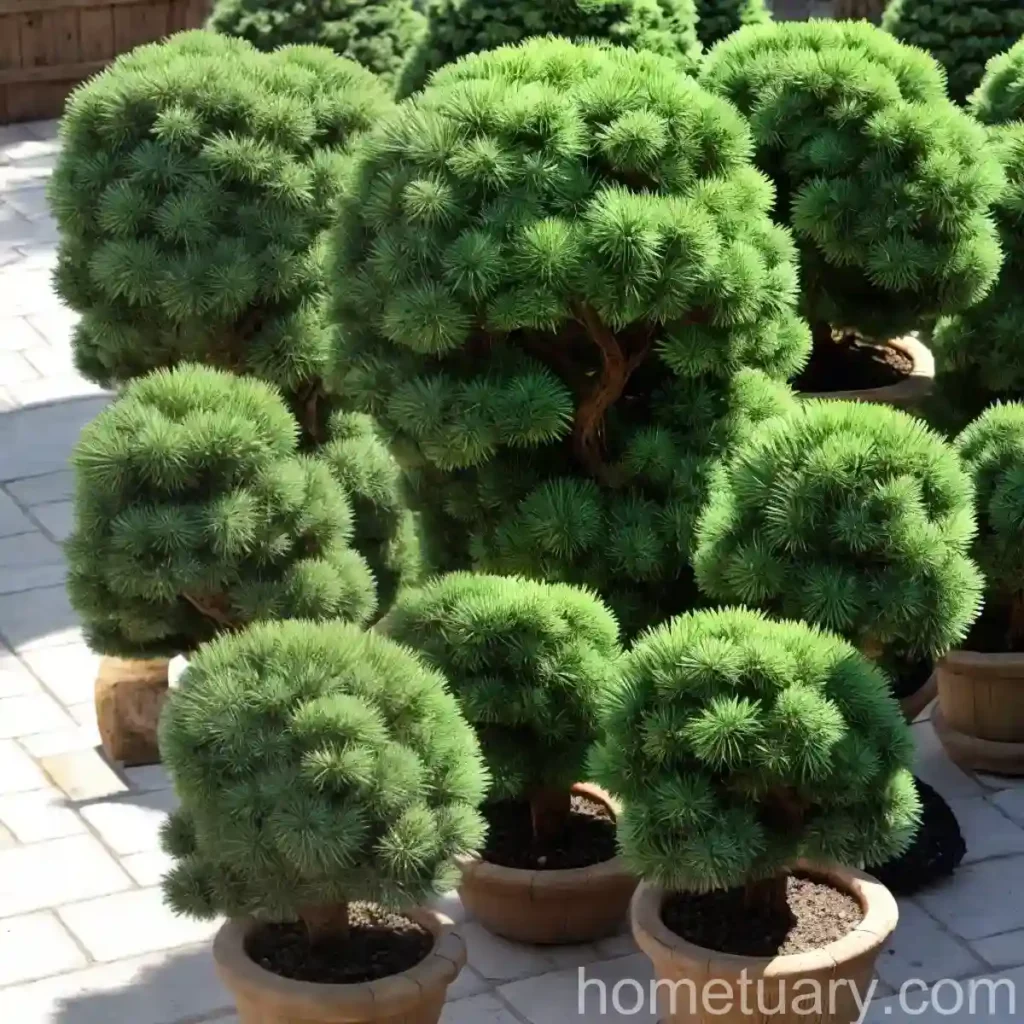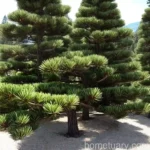Dwarf Siberian Pine (Pinus pumila ‘Compacta’): A Fascinating Landscape Wonder
In the world of horticulture, the dwarf Siberian pine, scientifically known as Pinus pumila ‘Compacta’, holds a special place as a versatile and visually appealing plant in landscapes. This unique coniferous species offers a range of benefits and an interesting array of characteristics, making it a subject of great interest for plant enthusiasts, landscapers, and botanists around the globe.
What is Plant: Dwarf Siberian Pine (Pinus pumila ‘Compacta’)?
The dwarf Siberian pine, or Pinus pumila ‘Compacta’, belongs to the Pinaceae family and is native to the subarctic regions of Asia, particularly the Siberian taiga, Japan, and Korea. It is a slow-growing, densely branched evergreen tree with a compact and spherical form. The dwarf Siberian pine is renowned for its petite size, making it an ideal choice for small gardens, containers, and rockeries. Its striking needle-like foliage and ability to withstand harsh environmental conditions further enhance its appeal among gardeners and landscape designers.
Key Takeaways – Dwarf Siberian Pine (Pinus pumila ‘Compacta’)
Characteristics:
– Slow-growing coniferous tree
– Compact and spherical form
– Needle-like foliage
– Densely branched structure
– Adaptable to harsh environmental conditions
Cultivation:
– Well-drained soil
– Adequate sunlight
– Minimal pruning requirements
– Suitable for containers
– Cold-hardy and tolerant of subarctic climates
Uses:
– Ornamental landscape plant
– Container gardening
– Rock gardens
– Accent plant in small spaces
Maintenance:
– Low maintenance
– Moderate watering needs
– Suitable for various soil types
– Minimal disease and pest susceptibility
With its compact size, unique appearance, and resilience, the dwarf Siberian pine has gained popularity for its diverse uses in landscaping projects and as an attractive ornamental plant in gardens.
Let’s delve into the specifics of cultivating and caring for the dwarf Siberian pine, exploring its water, sunlight, soil, fertilizer, and pruning requirements, as well as propagation methods, common diseases, and tips from botanists.
Culture
Cultivating the dwarf Siberian pine requires attention to specific environmental factors to ensure its optimal growth and health. From soil and sunlight to watering and pruning, understanding the cultural requirements of this plant is essential for successful cultivation.
Water
The dwarf Siberian pine prefers well-drained soil and is relatively drought-tolerant once established. However, it’s important to provide consistent moisture, especially during its initial establishment period. Deep, infrequent watering is ideal to encourage deep root growth and overall resilience to dry conditions.
Sunlight
This coniferous species thrives in full sun to partial shade. When selecting a planting location, ensure that the site receives adequate sunlight, particularly in cooler climates, to promote healthy growth and vibrant foliage color.
Fertilizer
Given its adaptability to nutrient-poor soils, the dwarf Siberian pine generally requires minimal fertilization. However, providing a balanced, slow-release fertilizer in early spring can support its growth and overall vigor.
Soil
The plant thrives in well-drained, acidic soils. It is crucial to avoid waterlogged conditions, as excessive moisture can lead to root rot. Adding organic matter to the soil can aid in moisture retention while maintaining proper drainage, creating an optimal growing environment for the dwarf Siberian pine.
Pruning
Minimal pruning is typically required for the dwarf Siberian pine. However, removing any dead or damaged branches can enhance its overall appearance and support healthy growth. Regular monitoring of its form and structure will help in identifying any pruning needs, which are usually minimal due to its compact and naturally symmetrical shape.
Propagation
Propagating the dwarf Siberian pine can be achieved through several methods, including seed propagation and vegetative techniques such as grafting and cutting propagation. Each method offers its own advantages and challenges, and selecting the most suitable approach depends on the resources and expertise available to the grower.
Seed Propagation
- Collect mature cones from the parent plant.
- Extract the seeds from the cones and prepare them for sowing.
- Sow the seeds in a well-draining, acidic growing medium.
- Maintain consistent moisture and provide adequate sunlight for germination.
Grafting
- Select a suitable rootstock for grafting purposes.
- Prepare the scion by taking a healthy cutting from the parent plant.
- Carefully join the scion to the rootstock using the appropriate grafting technique.
- Provide the necessary care and support for the grafted plant to ensure successful union and growth.
Cutting Propagation
- Take semi-hardwood cuttings from the parent plant during the appropriate season.
- Prepare the cuttings by removing excess foliage and treating the base with rooting hormone.
- Plant the cuttings in a well-draining, moist growing medium and provide a conducive environment for root development.
Container Popularity
The dwarf Siberian pine’s compact size and attractive appearance make it an excellent choice for container gardening. Whether placed on patios, balconies, or as a centerpiece in larger gardens, this versatile plant adds a touch of elegance and greenery to any outdoor space.
Common Diseases
Despite its resilience, the dwarf Siberian pine may encounter certain diseases that require prompt attention to prevent adverse effects on its health and appearance. Understanding these common diseases and their management is essential for maintaining the plant’s vitality.
Disease Diagnosis
- Diplodia Tip Blight: Identified by dieback and discoloration of the needles, particularly at the tips. Fungal spores may also be present on affected areas.
-
Management: Prune and remove infected branches, enhance air circulation, and consider fungicidal treatments.
-
Needle Cast: Characterized by the browning and premature shedding of needles, often caused by fungal infections.
- Management: Implement proper sanitation measures, promote plant vigor through adequate care, and utilize fungicidal treatments if necessary.
Common Pests
While the dwarf Siberian pine is relatively resistant to pests, occasional pest infestations may occur, requiring vigilant monitoring and appropriate management strategies to minimize their impact on the plant.
Botanist’s Tips
To ensure the optimal health and appearance of the dwarf Siberian pine, here are several key tips from seasoned botanists and horticulturists:
- Regularly monitor for signs of disease and pest infestations, addressing any issues promptly to prevent widespread damage.
- Implement a consistent watering schedule, adjusting based on environmental conditions and the plant’s specific needs.
- Provide sufficient spacing when planting multiple dwarf Siberian pines to allow for proper air circulation and avoid overcrowding.
Fun Facts
- The dwarf Siberian pine is well-adapted to extreme cold, with the ability to thrive in subarctic climates, making it an ideal choice for colder regions.
- Its compact, rounded form and vibrant green foliage create a striking visual impact in garden landscapes and containers.
- The pine cones of the dwarf Siberian pine add an ornamental touch, showcasing its natural beauty and biological significance.
Links to External Resources
Enhance your knowledge of the dwarf Siberian pine with the following resources:
-
Royal Horticultural Society – Pinus pumila ‘Compacta’
-
University of Florida IFAS Extension – Dwarf Siberian Pine
-
Missouri Botanical Garden – Pinus pumila ‘Compacta’
-
American Conifer Society – Dwarf Siberian Pine
-
The Spruce – Growing Miss Kim Lilac and Compact Dwarf Korean Lilac
This collection of reputable sources offers valuable insights into the cultivation, care, and distinct characteristics of the dwarf Siberian pine.
As a versatile and visually appealing landscape wonder, the dwarf Siberian pine, or Pinus pumila ‘Compacta’, continues to captivate the interest of plant enthusiasts and horticulturalists alike. Whether admired for its compact form, resilient nature, or ornamental value, this remarkable coniferous species remains a valuable addition to diverse gardening and landscaping projects. By understanding its cultural requirements, maintenance considerations, and unique attributes, enthusiasts can ensure the successful growth and enduring beauty of the dwarf Siberian pine in their outdoor spaces.















